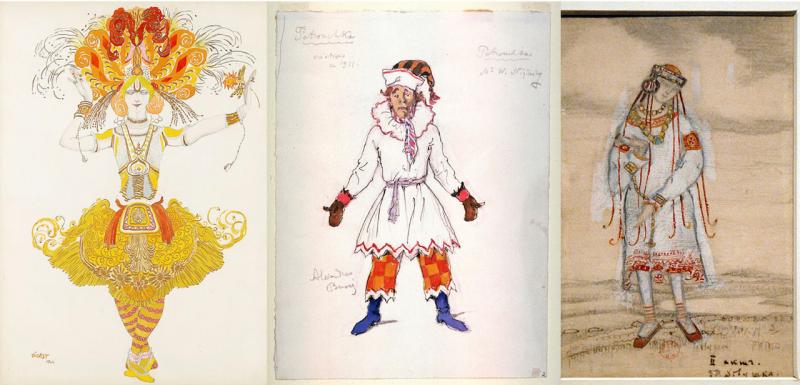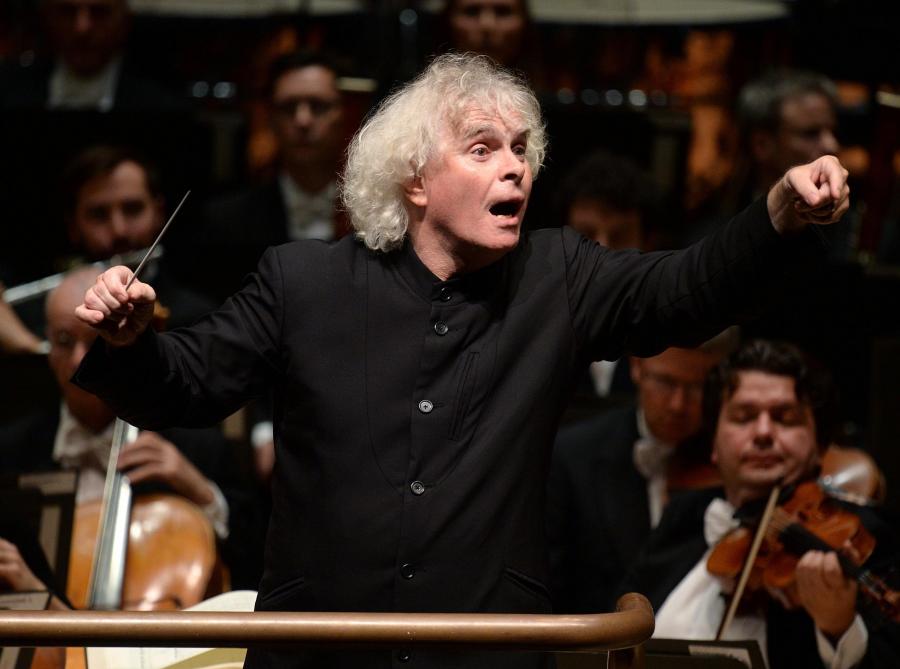Stravinsky Ballets, LSO, Rattle, Barbican review - the big three burn with focused energy | reviews, news & interviews
Stravinsky Ballets, LSO, Rattle, Barbican review - the big three burn with focused energy
Stravinsky Ballets, LSO, Rattle, Barbican review - the big three burn with focused energy
Perfect teamwork in miracles of song, rhythm and colour

“Next he’ll be walking on water,” allegedly quipped a distinguished figure at the official opening of Simon Rattle’s new era at the helm of the London Symphony Orchestra. Well, last night, with no celebratory overload around the main event, the homecomer was flying like a firebird, and taking a newly galvanised orchestra with him, at the start of another genuine spectacular.
This journey from the compendium-salute to the Russian romantic tradition which put Stravinsky on the map in 1910 to the dawn of another age in sound and rhythm within three years – in Petrushka every inch as much as The Rite of Spring – was so exhilarating that by the celebratory end of The Firebird you were delirious with anticipation of the second and third acts.
Players were prepared to go the extra mile as singer-actors in three operas without words
Gone were all the peripheral sound and vision reported in the opening concert – though, to be honest, it wouldn’t harm the LSO to adopt the Philharmonia’s principle of supertitles to describe the myriad choreographic score-indications, especially in the mimetic stretches of the complete Firebird. This time the focus was entirely on Rattle’s seemingly healthy relationship with players prepared to go the extra mile as singer-actors in three operas without words. His gestures were compact and often minimal, despite plenty of fierce ogre-faces; if only he'd apply this rigour, plus a bit of the freedom he sometimes lacks, to late-romantic scores, still an Achilles Heel.
What personality there was in the playing. I’d never noticed quite how brilliantly and definitely violinist Roman Simovic co-leads from the front desk with Carmine Lauri; their warm embrace at the end of the epic spoke volumes. It was strange that Rattle only gave selective post-Firebird stand-ups: though Timothy Jones’ horn solo as the Prince in Kashchey’s enchanted garden falls in love with the lead Princess was every inch as nuanced as the great folksong solo ushering in the day, oboist Olivier Stankiewicz and flautist Gareth Davies proved equally outstanding. The colours, as always with Rattle (pictured below by Doug Peters/PA Wire), were fine-tuned, but I wasn’t expecting quite that depth of emotion in the triumph of good over evil; what used to be four pianissimos in the string tremolos before the dawn in his CBSO interpretation now became at least five, ppppp, no easy task in the Barbican. Petrushka plunged us into a pell-mell fairground that was at the same time razor-sharp, strings no second fiddle as crowd and giant accordion to the many songs of wind and brass, never more luridly brilliant than in this performance. It might have been tempting to bring in a famous pianist for the Rattlethon as the concertante figure in manic-depressive Petrushka’s booth, but Philip Moore knew exactly how to advance and retreat in tandem with the semitonal clarinets – first lugubriously peering, then fierce – and there were opportunities for all brilliantly taken, not least by Ross Knight’s bear lumbering to Chi-Yu Mo’s E flat piping. This was a tough evening for the brass, and you could forgive a few rough edges, but Philip Cobb held his nerve leading Petrushka’s ghost along the roof. Details again fine-tuned, down to the softest final pizzicato in the four notes which so dissatisfied Diaghilev – what, no flourish to bring down the house? – but which worked so well between the massive endings of the outer-panel ballets.
Petrushka plunged us into a pell-mell fairground that was at the same time razor-sharp, strings no second fiddle as crowd and giant accordion to the many songs of wind and brass, never more luridly brilliant than in this performance. It might have been tempting to bring in a famous pianist for the Rattlethon as the concertante figure in manic-depressive Petrushka’s booth, but Philip Moore knew exactly how to advance and retreat in tandem with the semitonal clarinets – first lugubriously peering, then fierce – and there were opportunities for all brilliantly taken, not least by Ross Knight’s bear lumbering to Chi-Yu Mo’s E flat piping. This was a tough evening for the brass, and you could forgive a few rough edges, but Philip Cobb held his nerve leading Petrushka’s ghost along the roof. Details again fine-tuned, down to the softest final pizzicato in the four notes which so dissatisfied Diaghilev – what, no flourish to bring down the house? – but which worked so well between the massive endings of the outer-panel ballets.
Is Rattle’s – are everyone else’s – Rite(s) of Spring too well known by now? It’s true that there are few of the interpretative idiosyncrasies which make one sit up and listen afresh from the likes of crazy Teodor Currentzis (check out an astonishing new recording with his Russian orchestra). It might also be more rewarding to have every song in the work – and there are many – phrased as individually and beautifully as Rachel Gough’s bassoon at the start, given total freedom, or the string groups in the atmospheric, jungly introduction to Part Two (muted trumpets sounding as if offstage always a Rattle speciality).
Yet none of the climaxes failed to hit its focused target; even if a colleague found much of it “too slow”, the point is that highest energy, which the LSO still somehow found in the third part of an exhausting evening, will always fill the spaces. The polyrhythms at the height of “Procession of the Sage”, a “Glorification of the Chosen One” which hit this listener right in the gut, and tireless horns gilding the “Sacrificial Dance” all struck afresh. I only hope more folk tune in to the YouTube livestream of Sunday’s repeat performance than apparently did for the Berlioz; and that children and teenagers everywhere – not enough of them in last night’s audience – get the Stravinsky bug from watching. If Rattle can simply engage a new generation in some live-wire music-making, his appointment will have been worth its salt for that alone.
- Broadcast on BBC Radio 3; listen for the next month on the BBC iPlayer
- Sunday's repeat performance sold out; watch the live stream
- Read more classical music reviews on theartsdesk
rating
Share this article
The future of Arts Journalism
You can stop theartsdesk.com closing!
We urgently need financing to survive. Our fundraising drive has thus far raised £49,000 but we need to reach £100,000 or we will be forced to close. Please contribute here: https://gofund.me/c3f6033d
And if you can forward this information to anyone who might assist, we’d be grateful.

Subscribe to theartsdesk.com
Thank you for continuing to read our work on theartsdesk.com. For unlimited access to every article in its entirety, including our archive of more than 15,000 pieces, we're asking for £5 per month or £40 per year. We feel it's a very good deal, and hope you do too.
To take a subscription now simply click here.
And if you're looking for that extra gift for a friend or family member, why not treat them to a theartsdesk.com gift subscription?
more Classical music
 theartsdesk at the Three Choirs Festival - Passion in the Cathedral
Cantatas new and old, slate quarries to Calvary
theartsdesk at the Three Choirs Festival - Passion in the Cathedral
Cantatas new and old, slate quarries to Calvary
 BBC Proms: Estonian Philharmonic Chamber Choir, Kaljuste review - Arvo Pärt 90th birthday tribute
Stillness and contemplation characterise this well sung late-nighter
BBC Proms: Estonian Philharmonic Chamber Choir, Kaljuste review - Arvo Pärt 90th birthday tribute
Stillness and contemplation characterise this well sung late-nighter
 BBC Proms: Kholodenko, BBCNOW, Otaka review - exhilarating Lutosławski, underwhelming Rachmaninov
Polish composers to the fore in veteran conductor’s farewell
BBC Proms: Kholodenko, BBCNOW, Otaka review - exhilarating Lutosławski, underwhelming Rachmaninov
Polish composers to the fore in veteran conductor’s farewell
 theartsdesk at the Pärnu Music Festival 2025 - Arvo Pärt at 90 flanked by lightness and warmth
Paavo Järvi’s Estonian Festival Orchestra still casts its familiar spell
theartsdesk at the Pärnu Music Festival 2025 - Arvo Pärt at 90 flanked by lightness and warmth
Paavo Järvi’s Estonian Festival Orchestra still casts its familiar spell
 BBC Proms: Batsashvili, BBC Scottish Symphony Orchestra, Ryan Wigglesworth review - grief and glory
Subdued Mozart yields to blazing Bruckner
BBC Proms: Batsashvili, BBC Scottish Symphony Orchestra, Ryan Wigglesworth review - grief and glory
Subdued Mozart yields to blazing Bruckner
 Classical CDs: Hens, Hamburg and handmaids
An unsung French conductor boxed up, plus Argentinian string quartets and baroque keyboard music
Classical CDs: Hens, Hamburg and handmaids
An unsung French conductor boxed up, plus Argentinian string quartets and baroque keyboard music
 BBC Proms: McCarthy, Bournemouth SO, Wigglesworth review - spring-heeled variety
A Ravel concerto and a Walton symphony with depth but huge entertainment value
BBC Proms: McCarthy, Bournemouth SO, Wigglesworth review - spring-heeled variety
A Ravel concerto and a Walton symphony with depth but huge entertainment value
 BBC Proms: First Night, Batiashvili, BBCSO, Oramo review - glorious Vaughan Williams
Spirited festival opener is crowned with little-heard choral epic
BBC Proms: First Night, Batiashvili, BBCSO, Oramo review - glorious Vaughan Williams
Spirited festival opener is crowned with little-heard choral epic
 Interview: Quinteto Astor Piazzolla on playing in London and why Mick Jagger's a fan
Music Director Julián Vat and pianist Matias Feigin compare notes on Piazzolla
Interview: Quinteto Astor Piazzolla on playing in London and why Mick Jagger's a fan
Music Director Julián Vat and pianist Matias Feigin compare notes on Piazzolla
 Classical CDs: Bells, birdsong and braggadocio
British contemporary music, percussive piano concertos and a talented baritone sings Mozart
Classical CDs: Bells, birdsong and braggadocio
British contemporary music, percussive piano concertos and a talented baritone sings Mozart
 Siglo de Oro, Wigmore Hall review - electronic Lamentations and Trojan tragedy
Committed and intense performance of a newly-commissioned oratorio
Siglo de Oro, Wigmore Hall review - electronic Lamentations and Trojan tragedy
Committed and intense performance of a newly-commissioned oratorio

Add comment